Service Convergence in Next Generation Network
Wang Jun,Fu Tao
(ZTE Corporation, Shenzhen 518057, P. R. China)
Abstract:The convergence of communication services becomes a focus in the industry along with the requirement for full-service operation and technical development.Service convergence includes two aspects:The convergence of the fixed and mobile networks;and the convergence of traditional communications and lnternet services.This requires balancing the conflicts between the openness and operationability of terminal capability and network convergence.Unified authentication and authorization are the basis for service convergence in terms of operationability.Modular network and open terminal are technical solutions for the service convergence.

T he significance of communication service convergence is that users can access their subscribed services through the network anywhere,anytime and in any way.The convergence of mobile and fixed networks and the convergence of the communication and lPnetworks are two main convergence trends of network services.The first kind of convergence involves various access modes and the service differences in the mobile and fixed networks,which has not been solved in many years.The second kind of convergence requires the integration and convergence of the service modes in traditional communications and lT systems.Technologies for service convergence include the lPMultimedia Subsystem(lMS)proposed in the communication industry,Unified Communications(UC)proposed in the software industry and various partially improved technologies[1-3].
The NGN standards in the communications field divide the network into the access,bearer,control and service layers,which,plus the terminal,forms a five-layer structure.ln the data communication model,the network is divided into the communication sub-network and resource sub-network.The NGN is network-centric,with emphasis on operation and control,and in which the service provider is entirely different from the service consumer.The data communication model is based on the concept of peer,which allows the exchange between service provider and consumer.
Overemphasizing any of the two modes will result in an extreme hardship.
The former limits the representation of technical progress at the terminal side,and increases the network load,slowing down the network evolution and technical innovation.The latter is unable to ensure the profit from network operation and makes it hard to provide sustainable and quality-assured services.
Network convergence requires eliminating the conflict between convergence and diversity.Economic development allows the satisfaction of the people's basic demands.Personalized demands are getting more and more popular and become one of marketing focuses in recent years;it is the same picture in the communications market.Convergence should not be limited to controlling operator's cost only.lt should be an integration of diversified services.Convergence reflects its value by providing more diversified product portfolios for customers.
Another problem that should be solved for the convergence is on which layer the services are converged.lt includes two types of convergences,i.e.,client-end integration and network convergence.Solutions vary depending on different network layers.
(1)Service Layer
The same service for the same type of subscribers should provide a unified experience.Subscribers can customize service features and personal preferences,which labels the services with personalization.Services should have an integration capability to pack a group of subscriber-concerned services to one interface and one operation.
(2)Control Layer
Subscribers are not concerned about this layer.The purpose of unification is to reduce the cost of carriers.However,it has no corresponding layer in the lP network model.From another view,this layer is an overlapped network on the bearer network.lt mainly achieves the service discovery and routing,and subscriber Authentication,Authorization and Accounting(AAA).
(3)Bearer Layer
This layer is unified to lP.
(4)Access Layer
Different media provide different connectivity and Quality of Service(QoS).Diversity is inevitable.The diversity on the Access Layer ought to be screened depending on the terminal's integration capability.
(5)Terminal
Terminalshould have multiple access capabilities,including various wireless and wired access modes,and provide various service access interfaces and capabilities.The diversity of terminal capabilities can be adapted on the service layer,but it has a basic requirement of capability sets for specific services.
1 Service Convergence Modes
Aservice convergence model should consider what value the convergence mode can offer to the customers and what cost elements are required for the convergence implementation.The former studies customer demands and the later focuses on the implementation feasibility.
1.1 Convergence Scenarios
(1)Fixed-Mobile Convergence Mr.Lireceives an emergency notice from his company on the way home after work.He is asked to attend an urgent meeting with a European Project Team.Mr.Liaccesses the videoconference with the team using his Personal Digital Assistant(PDA)through a wireless network,and participates in the discussion.After arriving home,he switches the video over to his lPTVvideo terminal and the audio to a fixed phone to continue his discussion.
(2)Communication-lnternet Service Convergence
Mr.Wang is on a business trip to the U.S.After his arrival at the destination,he accesses the network using his PDA,and searches for and makes a reservation at the nearest Chinese restaurant through the web portal offered by the travel agency that has a partnership with the carrier to which he is subscribed.After days of business activities,there are still some days for the trip.So he accesses the lnternet to schedule severaldays of budget travelling,and reserves hotels and food and drinks.
Mr.Wang's network carrier has an agreement with the main chain service enterprises.Quality subscribers of the carrier can select to be a member of the enterprises automatically.The membership can be authenticated automatically through the carrier's phone number with no request needed.
1.2 Convergence Modes
Services are converged at two levels as viewed from the position where service logics are converged:
(1)Convergence at Terminal
This means the terminal should have the capability to combine multiple applications.For example,terminal integrates communication applications and web applications in one application.lt also provides support for new services by downloading plug-ins.
(2)Convergence at Network Side
For example,a Web 2.0 convergence portal site provides subscribers with an integrated service interface,which invokes desired services automatically and packs various separate combinations to provide a unified service experience,identification authentication and payment accounting.
The feasibility of any type of service convergence depends on its profit mode.Payment channel is a major profit mode besides the customer value and marketing channel that the service can provide itself.lnternet service subscribers are allover the world because of the globalization of the service provides.The essence of the profit mode unveiled by the Long Tail theory is to attract the public attention with a wide range of free services and then sale the public attention to a few industrial customers,for example,the advertisement mode through portal website and search engine.

The simple service convergences at the terminalcannot meet the requirement for the operational and sustainable development of the entire industrial chain,which also impedes the further improvement of subscriber experience.lt is necessary to make improvement at both terminal and network side to provide a win-win solution for both the subscriber and the carrier.
Carriers have established channels all over the cities and countryside and their sophisticated payment and credit systems.The carrier channels allow a win-win situation for both the lnternet service providers and telecom carriers.A successful example is that the revenues of the main domestic portal websites last year were mainly dependent on the Short Message Service(SMS)for mobile subscribers.However,such a cooperation and convergence is only limited to some special applications and cannot be extended to the more extensive communication services.
lf a unified framework is offered,any types of services can share subscriber groups and marketing and payment channels with carriers,who act as the service integrators and agents.ln this way,the win-win cooperation between the network carrier and the service provider can be expected.Establishing such a unified identification authentication and payment system based on the communication network is also a key problem for the service convergence.

▲Figure 1. Hierarchy network model.
2 Network Architecture of Service Convergence
2.1 Convergent Network Model
As a conclusion,the service-converged communication network is a service-centered open network with support for unified AAA.Figure 1 illustrates the conceptual model.Traditional telecom services are only a subset of network-provided services.All the products and services that can be provided through information flow are one type of service.The traditional telecom services have come to a saturation point along with its increasing service penetration.Without any conceptual extension,the development of traditional services will be far behind the social economy growth and will come down gradually.
ln fact,each industry is a desired competitor to others.They maintain their development by splitting a share from the totalsocial expense.As an information flow technology,communications systems substantially achieve their development by substituting the physical flow,such as mailing system and passenger transportation.
Traditional communications systems are located to a small development space and unable to attract more expense budgets from consumers.Therefore,they ought to be involved in more information flow processes.lt is impossible for telecom carriers to be all-around service providers.But their advantage is that they have telecom subscriber resources and that they control subscriber lDs,which helps them to establish a credible network for unified authentication.Moreover,as the end-channel agents,they facilitate the interface opening of the service providers through structural service interfaces.
Carriers can establish integrated service portals to provide competitive combined one-stop service,which is similar to the concept of Web 2.0 Mashup.lt is also an extension of the Parlay Open Service Architecture(OSA),which has existed in the telecom industry for many years,with only a conceptual extension to the non-traditional telecom services.
ln Figure 1,there are four service provider roles,which are the access network provider,service network carrier,service provider,and convergence portal.The service network carrier can offer multiple optionalservice providers and convergence portals when users subscribe to services.A user can also select to be a subscriber of the service network carrier and meanwhile a member of multiple interested service providers.
The later two roles can access the AAA infrastructure of the service network carriers for unified AAA.Both settlement and service wholesale are supported between the service provider and the service network carrier.
The terminal may support both customized multi-service convergence applications and multiple separate applications.Multiple application programs are invoked through service identification.Services are converged through the modularization of the terminal system,for example,the integration of Microsoft Office Communicator and other Office software.
Key points of service convergence include the following:
(1)Unified Service Addressing
Any type of terminal and application can present its desired service in a uniform and identicalway.And service addressing type can be associated with application program on the terminal.lt is very easy to achieve service application convergence on the terminal through software modularization and thus provide subscribers with a superior experience.
(2)Unified ldentification Management
On the one hand,unified identification management allows the subscribers to log in to multiple websites for one-stop service without the need of repeated registrations,which reduces subscribers'total costs.On the other hand,it reduces the difficulty of charge settlement and allows the growth of marketing channels for communication services,and thus allows the creation of a healthy ecological niche.
(3)Open Service Provisioning Platform Coupled Loosely with Network
Coupling loosely with network allows the services to be independent of specific access techniques,which facilitates the independent evolution of the services.
2.2 Unified Authentication
2.2.1 Overview
Unified authentication ensures the creditability of subscriber identities.Creditable identification is one of the prerequisites for business transactions.Meanwhile,carriers providing unified authentication also allow the service providers to use their subscriber credit database,providing a more secure financing channelfor the transactions.Public Key lnfrastructure(PKl)is an identification authentication system widely used for the lnternet.However,it has a disadvantage that each website using this system issues its own digital certificate,which is not interoperable.3GPPputs forward Generic Authentication Architecture(GAA),its own solution for unified authentication,which uses the current 3G security technology directly to extend the 3GPP terminal identification authentication from the telecom network to the lPdomain.lt can also be combined with PKl to provide a more flexible and reliable security system.
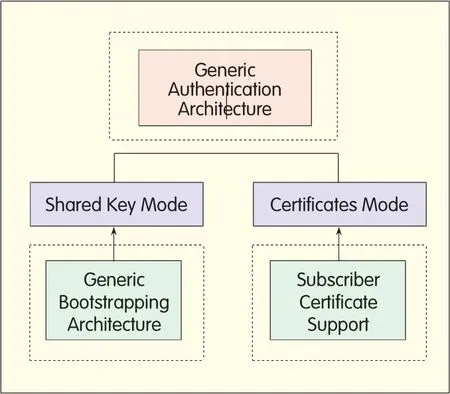
▲Figure 2. Generic Authentication Architecture.
2.2.2 GAA
GAA is a security architecture for unified authentication put forward by 3GPP,as shown in Figure 2.Communications and lPservices use the same authentication mechanism to provide an infrastructural support for service convergence.GAA supports unified authentication through shared key or digital certificate.
When the Generic Bootstrapping Architecture(GBA)of shared key is used,3GPP's current network user identification architecture can be reused.Digital certificate allows terminal card number to be used as identification for unified authentication without the need to reallocate other identification.This allows the system applications using the GAA architecture to directly use 3GPPterminal card numbers and terminal numbers as subscriber identities.This also allows Single Sign-On(SSO)and single authentication for website,lTsystem and telecom network.Carriers can also be commissioned to directly collect the charges other than those for the services they provide.Smallpayments can be deducted directly from mobile phone accounts[4-7].
GBA,as shown in Figure 3,is a unified authentication architecture that uses shared key.lt introduces a Bootstrapping Server Function(BSF)entity as the bootstrapping function unit for unified authentication.When a terminal supports the GBA function,it interacts with BSFfirst to initiate a bootstrapping process.The bootstrapping server records its authentication vector and Bootstrapping Transaction lD(B-TlD).When User Equipment(UE)needs to access a network application server that supports GBA,it includes a B-TlD in an application request.The network access function entity queries the bootstrapping server for relevant security parameters according to the B-TlD.The bootstrapping server returns security parameters and the primary key for protecting the Ua interface.Network Access Function(NAF)initiates a key negotiation process to the UE.The successive communication between the UEand the NAFis protected by the negotiated key.lf the NAFfinds the UE's security parameters are expired or do not comply with the local policies,it notifies the UEto re-initiate a bootstrapping process.After receiving the notification,the UEshould initiate a new bootstrapping process through the Ub interface.When the UEuses a digital certificate,GBA can be used as an identification authentication mechanism for certificate issue and update.
The NAFin such architecture can be a communication service server or an lnternet service portal,or even the lT system server of an enterprise.This allows the unified identification authentication to be used for combining the communication service subscriber identification with lnternet service and enterprise lTsystem.
2.3 Generic User Profile (GUP)
GUPis a convergent user data access architecture defined by 3GPP.lt is basically designed with the consideration of subscribers for the unified access to the user profiles in different networks and services.ln the prerequisites for designing the GUP,user-related data are allowed to be stored in different entities.For example,one subscriber can access through Digital Subscriber Lines(DSL),3GPP/3GPP2 networks or Worldwide lnteroperability for Microwave Access(WiMAX).The subscriber also has lMSand other multimedia service subscription.GUPallows the user data to be stored on the AAA server,Home Location Register(HLR),Home Subscriber Server(HSS)and application server.GUPprovides it with a unified access framework,thus reducing the complexity of data access in network and service convergence[8].
ln GUP,user-related data is composed of multiple data components.Each component may consist of several data units.ln a network,only one master instance may exist in each component of user data,but one or more copies of instances may exist.User data in unit of component can be stored in different network entities.Applications can access all the authorized data using a standard interface through a unified access portal.The portal function is provided by a GUP server.The GUPserver is responsible for hiding the data distribution details in the management domain.lt applies relevant security and operation policies to ensure data security and the accounting function necessary for the operation.
Figure 4 is the conceptual view of GUP,while Figure 5 shows the GUP architecture.
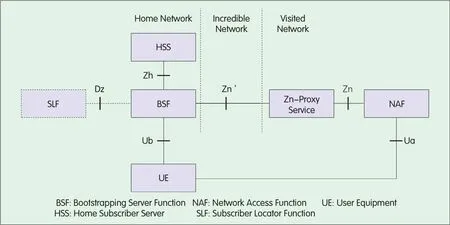
▲Figure 3. Generic Bootstrapping Architecture.
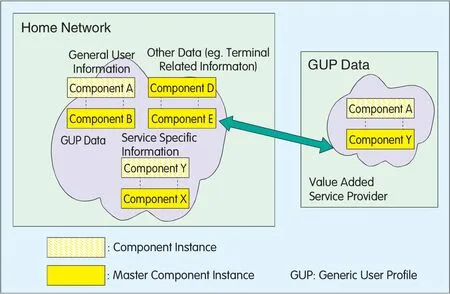
?Figure 4.Conceptual view of GUP.
To ensure the interoperability of the access interfaces and various applications,the Rg and Rp interfaces use the Simple Object Access Protocol(SOAP)over Hyper Text Transfer Protocol(HTTP)to transmit user data encapsulated in the Extensible Markup Language(XML)format.The GUPserver either operates in proxy mode or in redirect mode.ln the proxy mode,the access messages arrive at the GUP server.GUPis responsible for accessing the corresponding GUPdata repository and combining the data in a manner specified by the policies if possible.ln the redirect mode,the GUPserver returns the address of the entities where the user data component is actually stored to the application.Thereafter,the application accesses the entity directly to acquire desired data.
Rg is defined as an inter-carrier interface and Rp is an intra-carrier interface.When a GUPdata repository is located on a third-party provider,the GUPserver accesses the data using the Rg interface.
2.4 Service-Oriented Convergent Network Architecture
Generally,the requirement of network convergence greatly increases the complexity and scale of the network.The disadvantage of the network constructed in a traditional close coupling mode is that new service provisioning often requires upgrading the entire network,which has very high costs for providing new services.The popularization of such networks is very slow,which greatly lowers the commercialvalue of new services and becomes one of the major reasons for slow innovation of communication network services in the recent years.ln addition,it is very difficult for such a network and service coexistence mode to allow the convergence of different technologies and the services with distinct industrial characteristics and regional features.
As viewed from the solutions for reducing the software complexity in the software industry,the solutions have evolved through process-oriented,object-oriented and service-oriented improvement continuously.As viewed from the real world,the way to solve the transaction complexity is fine division of labor and institutionalized flow.
Therefore,the construction of communication network can also be based on such a theory.First,an idea of Divide and Conquer is used to achieve network modularization,trying to decouple between Network Elements(NEs),and between networks and services.The next solution is the standardization of component interaction,which lowers the cost of interactions between network and service so that they can evolve in a relatively independent way.
ln a service-centric view,the network is reconstructed based on a Service-Oriented Architecture(SOA).ln a target network,the basic network elements is the logical atomic services that create subscriber values.These atomic services open interfaces.Other service providers can establish a series of convergence flow services based on the atomic services,which provides the subscribers with convenient one-stop services and makes it infinitely possible for service portfolio innovation.The premise of commercial service is profitability.The unified authentication and authorization framework mentioned above can still be used in the SOA communication network[8-11].
As shown in Figure 6,in a service-oriented view,all the network entities can be divided into four roles:
(1)Terminal
Terminal is the final service presenter and consumer,having the capability to run various service software applications and access multiple networks.
(2)Access and Bearer
This role acts as information transmission media,providing connections and achieving terminal access authentication and admission control in conjunction with the service support layer.
(3)Service Layer
The service layer provides subscribers with desired service components and service portfolio,which is the core value of network.
(4)Service Support
This role provides other capabilities necessary for service and operationachievement,including but not limited to service discovery,unified user data management,authentication and authorization.
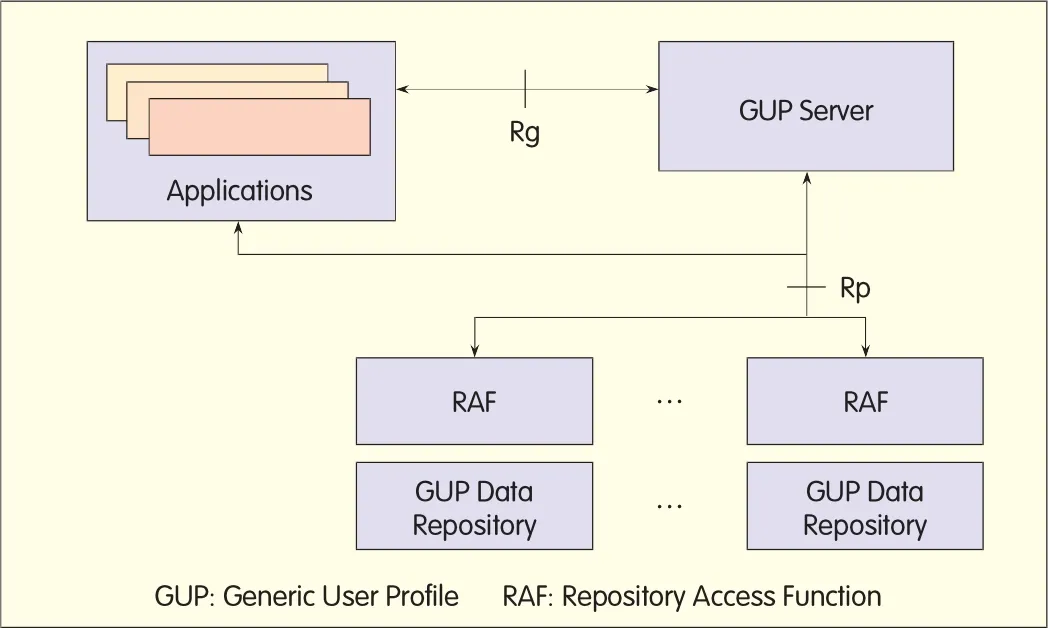
Figure 5.?GUParchitecture.
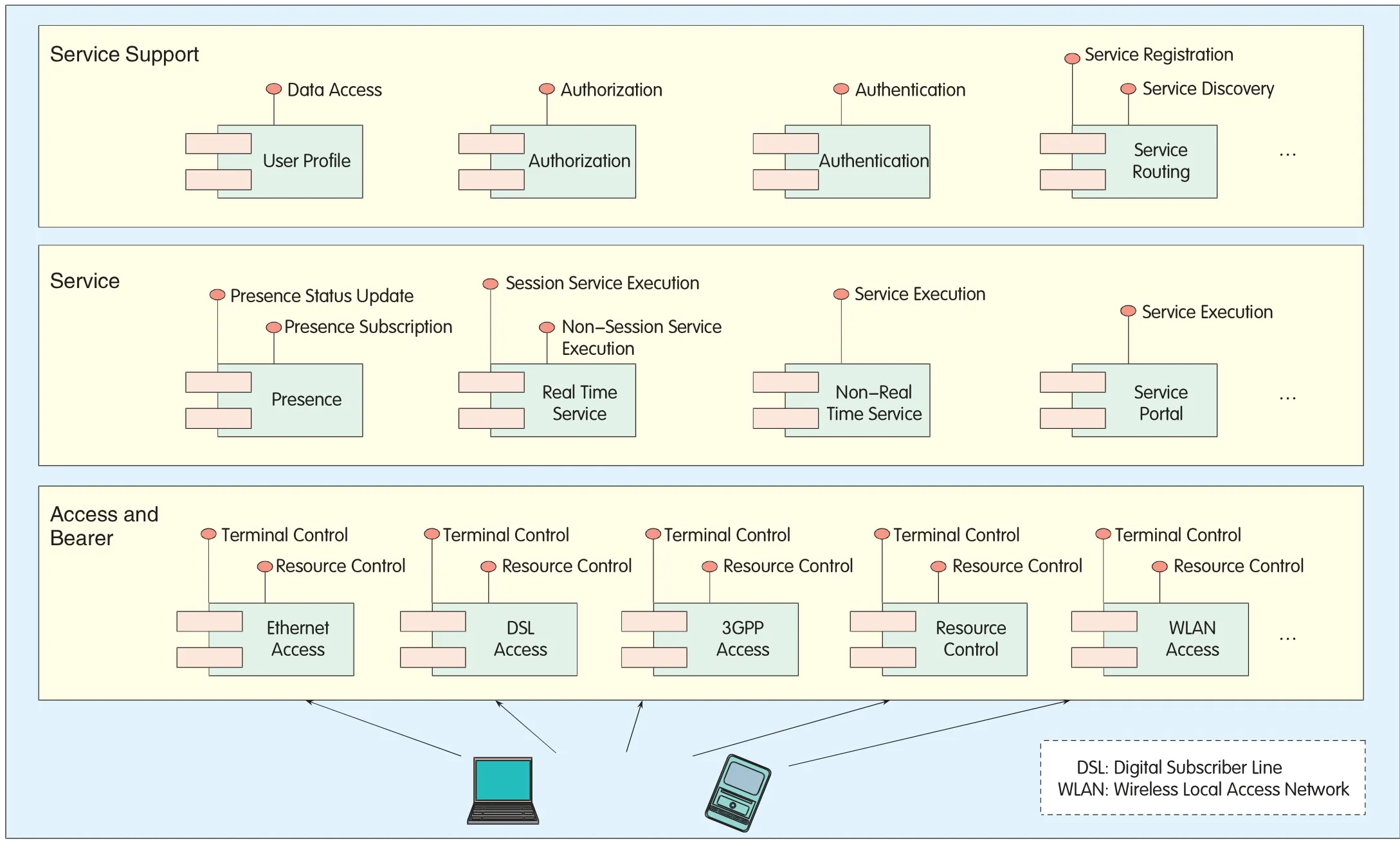
▲Figure 6. Service-oriented convergent network architecture.
2.5 Example of Convergent Service Flow
The service layer provides users and other service execution entities with open interface for access.lnterfaces among three network layers are opened to allow the innovation of complex services.No other coupling relationship exists among the NEs except the interfaces opened for access.Generally,the interfaces opened to the access and bearer layer and the service support layer can also be called a type of service,but most of them are not presented to users directly.
Figure 7 uses the case of the convergence of communication and lnternet services described in Section 1.1 as an example to illustrate the service implementation flow.
Mr.Wang's PDAgot a list of travel service homepages through the service discovery server located in the home network.He selected a homepage to visit its travel service.The travel service authenticated and authorized the terminal for travel services through the GAA&GUPin its home network.After successful authentication and authorization,the travel service requested map information to the map service and returned it to the terminal with a service page.Mr.Wang clicked the Nearest Chinese Restaurant button and the travel service forwarded the request agent to the map service.The map service returned a Chinese restaurant list(the user reported his location information or the travel service got the information by querying the location service of the user's home network).The travel service forwarded the list to the terminal.When Mr.Wang selected and reserved a restaurant,the travel service sent an order to relevant service personnelthrough the reservation service of the restaurant.Thus the flow is finished.
This example combines the communication service process with the automatic management of enterprise orders.However,it is a convergence of interactive services,similar to a model integrating real-time voice and video services.
3 Conclusions
The scope of services,in a broad sense,is far beyond the traditional telecom services.lt is impossible to expect the service convergence through one form of network.Only the loosely coupled networks with diversity can ensure service diversity and healthy development.The service convergence on this basis is reflected at the service and terminal levels.To ensure such a convergence,services must be provided in a standardized manner,which is,as viewed from SOA,network modularization and service modularization.On the basis of modularization,it is very easy for any form of service packaging and product portfolio innovation.And in addition,the innovation of a single service can be included in to the entire network service system very easily.
lMSrealizes the convergence of the fixed and mobile networks in the traditional communications,which is the first step to the network modularization in terms of network architecture.However,its disadvantage is that it only focuses on the SlP-based real-time services and is unable to cover the scope of communication services in broad sense.
The convergence of traditional communication and lTservices requires more open network architecture.
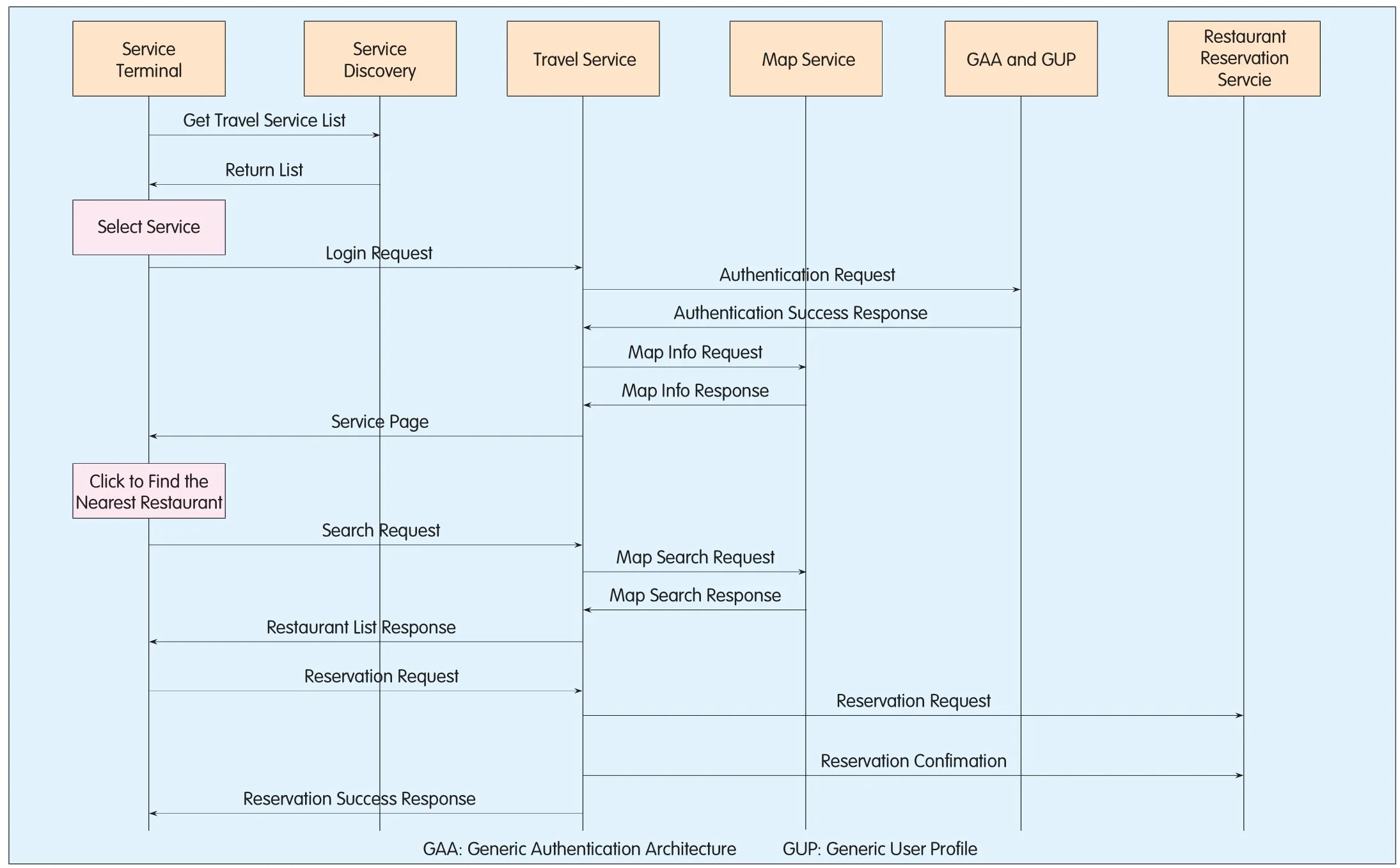
▲Figure 7. A convergent service flow example.
However,it is impossible to fully discard the existing large-scale telecom assets dedicated to the real-time voice communication and based on closed architecture.lt is also impossible to fully improve it within one night.Therefore,a transition technology is needed to relieve the shortage of capital,technology and time.lMSoffers a possible choice.
On the other hand,the value of service convergence is user experience.Service convergence will inevitably lead to the diversity of information presented on the terminal,not only voice and video.
The presence application of these services should be downloaded on demand and should be modularized like network.This has already been achieved on the PC terminal.The development of chip technology and the industrial requirements will lead the hand-set terminal products to a way similar to that for PC.
- ZTE Communications的其它文章
- ZTE is First to Pass Third-Party UE TD-LTE Test
- ZTESDRBase Station Records over 100,000 Volume Shipment
- ZTE Records 10 Million Terminal Shipments in Q1 2009
- Cooperative Communication and Cognitive Radio (2)
- Open Access Standards for Telecom Service Capabilities
- IPv4 and IPv6 Migration in IMS Environment

